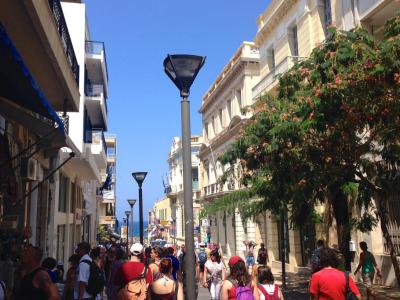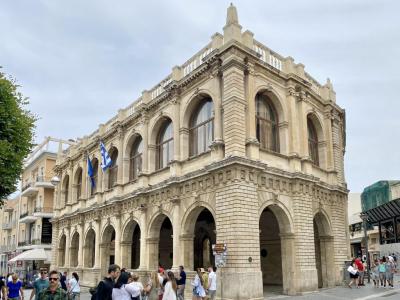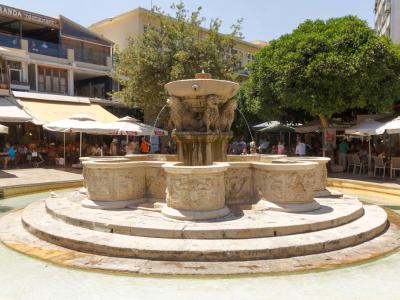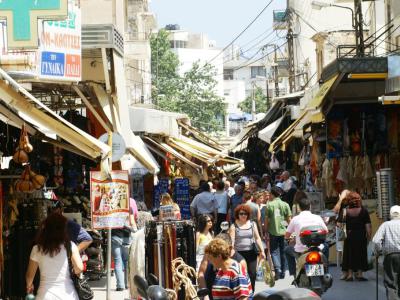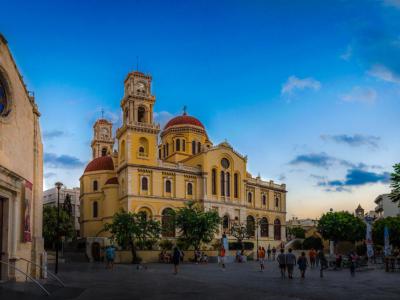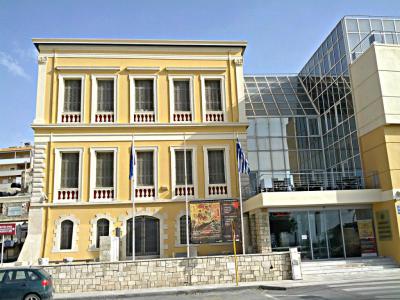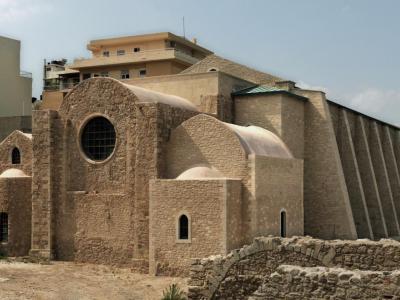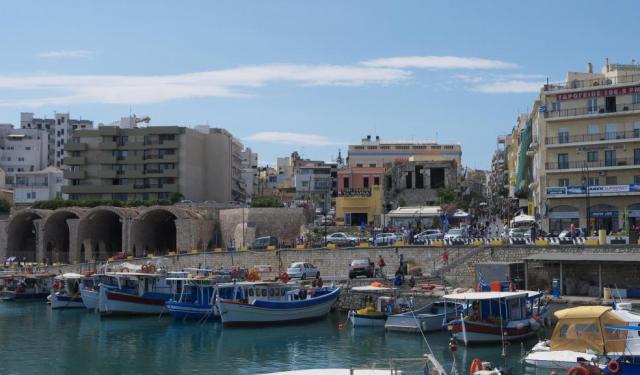
Heraklion Introduction Walking Tour (Self Guided), Heraklion
Heraklion is the vibrant capital of Crete and its primary port. The city traces its roots back to the Minoan era (from 2700 BC to 1450 BC). Under Minoan rule, the area flourished as a vital hub with the nearby palace of Knossos acting as its center of power and trade (in gold, ceramics, and saffron).
Following the Minoans' decline, Crete endured stagnation until the Roman occupation. The city itself was founded in 824 by the Arabs as the capital of the Emirate of Crete and served as a port haven for pirates targeting Byzantine shipping and territories in the Aegean. In 960, Byzantine forces conquered the city, establishing their control for the next 243 years.
In 1204, Heraklion was acquired by the Republic of Venice through a complex political arrangement involving the Fourth Crusade. The Venetians fortified the city extensively, transforming it into a strategic stronghold named Candia. This period, known as the Cretan Renaissance, shaped the city's identity for centuries to come. The picturesque Old Venetian Harbor and Venetian Loggia are a testament to that time.
After a 21-year siege in the Cretan War, Candia fell to the Ottomans in 1669. During the Ottoman rule, Candia – no longer the island's capital – was commonly referred to as the 'Big Castle' (Megalo Castro in Greek).
In 1898, the autonomous Cretan State was established, seeing Candia renamed "Heraklion" after the Roman port of Heracleum ("Heracles' city"). In 1913, along with the rest of the island, the city was incorporated into the Kingdom of Greece, and in 1971, became the capital of Crete once again.
Today, Heraklion is a cultural hub, blending the remnants of its storied past with the hustle and bustle of modern life. Still, many travelers who arrive here, quickly move on to other parts of the island, often missing out on the historical richness and multiple attractions in the city. We urge you not to repeat this mistake.
Come and experience the spiritual significance of Agios Minas Cathedral, a towering symbol of faith and devotion, or immerse yourself in the island's rich heritage at the Historical Museum of Crete, where artifacts and exhibits offer insight into its past. And, of course, no visit to Heraklion would be complete without exploring the imposing Castello del Molo, also known as Koules Fortress, standing guard over the sea.
The wonders of Heraklion are waiting to be discovered! Our self-guided tour will help you with that.
Following the Minoans' decline, Crete endured stagnation until the Roman occupation. The city itself was founded in 824 by the Arabs as the capital of the Emirate of Crete and served as a port haven for pirates targeting Byzantine shipping and territories in the Aegean. In 960, Byzantine forces conquered the city, establishing their control for the next 243 years.
In 1204, Heraklion was acquired by the Republic of Venice through a complex political arrangement involving the Fourth Crusade. The Venetians fortified the city extensively, transforming it into a strategic stronghold named Candia. This period, known as the Cretan Renaissance, shaped the city's identity for centuries to come. The picturesque Old Venetian Harbor and Venetian Loggia are a testament to that time.
After a 21-year siege in the Cretan War, Candia fell to the Ottomans in 1669. During the Ottoman rule, Candia – no longer the island's capital – was commonly referred to as the 'Big Castle' (Megalo Castro in Greek).
In 1898, the autonomous Cretan State was established, seeing Candia renamed "Heraklion" after the Roman port of Heracleum ("Heracles' city"). In 1913, along with the rest of the island, the city was incorporated into the Kingdom of Greece, and in 1971, became the capital of Crete once again.
Today, Heraklion is a cultural hub, blending the remnants of its storied past with the hustle and bustle of modern life. Still, many travelers who arrive here, quickly move on to other parts of the island, often missing out on the historical richness and multiple attractions in the city. We urge you not to repeat this mistake.
Come and experience the spiritual significance of Agios Minas Cathedral, a towering symbol of faith and devotion, or immerse yourself in the island's rich heritage at the Historical Museum of Crete, where artifacts and exhibits offer insight into its past. And, of course, no visit to Heraklion would be complete without exploring the imposing Castello del Molo, also known as Koules Fortress, standing guard over the sea.
The wonders of Heraklion are waiting to be discovered! Our self-guided tour will help you with that.
How it works: Download the app "GPSmyCity: Walks in 1K+ Cities" from Apple App Store or Google Play Store to your mobile phone or tablet. The app turns your mobile device into a personal tour guide and its built-in GPS navigation functions guide you from one tour stop to next. The app works offline, so no data plan is needed when traveling abroad.
Heraklion Introduction Walking Tour Map
Guide Name: Heraklion Introduction Walking Tour
Guide Location: Greece » Heraklion (See other walking tours in Heraklion)
Guide Type: Self-guided Walking Tour (Sightseeing)
# of Attractions: 11
Tour Duration: 2 Hour(s)
Travel Distance: 2.3 Km or 1.4 Miles
Author: nataly
Sight(s) Featured in This Guide:
Guide Location: Greece » Heraklion (See other walking tours in Heraklion)
Guide Type: Self-guided Walking Tour (Sightseeing)
# of Attractions: 11
Tour Duration: 2 Hour(s)
Travel Distance: 2.3 Km or 1.4 Miles
Author: nataly
Sight(s) Featured in This Guide:
- 25th of August Street
- Saint Titus Cathedral
- Venetian Loggia
- Saint Mark's Basilica
- Morosini Fountain (Lion's Fountain)
- Central Market
- Agios Minas Cathedral
- Historical Museum of Crete
- Saint Peter Monastery
- Old Venetian Harbor
- Castello del Molo (Koules Fortress)
1) 25th of August Street
Once called "Odos Planis" or "Illusion Street," 25th of August Street earned its ironic moniker due to the striking Neoclassical buildings that captivate visitors as they approach from the harbor. The street is now a paved pedestrian thoroughfare, lined with banks, travel bureaus, and tourist shops housed within these historic structures.
As you embark on your walk along 25th of August Street, the church of Saint Titus, the Loggia, and the Basilica of St Mark stand as architectural gems, each contributing to the street's allure. The street serves as a visual feast, bearing witness to the city's resilience and transformation after the catastrophic events of 1898.
The street's historical roots trace back to the Arab period in the 9th or 10th century, and it has consistently served as Heraklion's main artery, connecting the town center to the harbor. During the Venetian era, it was known as Ruga Maistra (Main Street), and in Ottoman times, it took on the name Vezir Tsarsi (Vizier's Market) after the Vezir Mosque.
The modern nomenclature of 25th of August Street bears the weight of a tragic event. On the 25th of August 1898, during the feast of St Titus, a frenzied Muslim mob committed a heinous act, resulting in the loss of many lives, including 17 British soldiers and the British Consul Lysimachos Kalokairinos. This violent episode prompted the Great Powers to intervene, leading to the protection of the island and, eventually, the Union of Crete with Greece in 1913.
As you embark on your walk along 25th of August Street, the church of Saint Titus, the Loggia, and the Basilica of St Mark stand as architectural gems, each contributing to the street's allure. The street serves as a visual feast, bearing witness to the city's resilience and transformation after the catastrophic events of 1898.
The street's historical roots trace back to the Arab period in the 9th or 10th century, and it has consistently served as Heraklion's main artery, connecting the town center to the harbor. During the Venetian era, it was known as Ruga Maistra (Main Street), and in Ottoman times, it took on the name Vezir Tsarsi (Vizier's Market) after the Vezir Mosque.
The modern nomenclature of 25th of August Street bears the weight of a tragic event. On the 25th of August 1898, during the feast of St Titus, a frenzied Muslim mob committed a heinous act, resulting in the loss of many lives, including 17 British soldiers and the British Consul Lysimachos Kalokairinos. This violent episode prompted the Great Powers to intervene, leading to the protection of the island and, eventually, the Union of Crete with Greece in 1913.
2) Saint Titus Cathedral
The Cathedral of Saint Titus stands as a significant Orthodox church in the heart of Heraklion, Crete, dedicated to the memory of Saint Titus. This architectural gem has witnessed a transformative history, evolving from its origins as the Yeni Cami ("New Mosque") to its present role as a revered Christian cathedral within the archdiocese of Crete.
The cathedral, with its distinctive square temple and prominent dome, showcases an eclectic architectural style. Constructed in 1869 based on the design by Athanasios Moussis, the church boasts a compelling exterior dominated by vertical elements. A stone-carved apse crowns the structure, adding to its visual allure.
Initially known as the Yeni Mosque, this building served the Muslim community until the geopolitical changes following the integration of Crete into Greece. The exchange of populations between the Balkans and Anatolia led to the restoration and consecration of the mosque for Orthodox Christian worship on May 3, 1925. Notably, the minaret of the mosque was removed during this transformation, marking a symbolic shift in its purpose.
A momentous event occurred on May 15, 1966, when the revered head of Saint Titus was returned to the church, a gesture from the city of Venice that further enriched the cathedral's historical and spiritual significance.
The cathedral, with its distinctive square temple and prominent dome, showcases an eclectic architectural style. Constructed in 1869 based on the design by Athanasios Moussis, the church boasts a compelling exterior dominated by vertical elements. A stone-carved apse crowns the structure, adding to its visual allure.
Initially known as the Yeni Mosque, this building served the Muslim community until the geopolitical changes following the integration of Crete into Greece. The exchange of populations between the Balkans and Anatolia led to the restoration and consecration of the mosque for Orthodox Christian worship on May 3, 1925. Notably, the minaret of the mosque was removed during this transformation, marking a symbolic shift in its purpose.
A momentous event occurred on May 15, 1966, when the revered head of Saint Titus was returned to the church, a gesture from the city of Venice that further enriched the cathedral's historical and spiritual significance.
3) Venetian Loggia
The Venetian Loggia stands as one of the most significant buildings from the Venetian period, offering a glimpse into the historical and cultural tapestry of Heraklion. The term "Loggia," derived from the Italian word for "lodge," hints at the building's original purpose as a gathering place for the elite and affluent members of society.
Constructed after 1541, with probable designs by Michel Sammicheli in the Palladian style, the Loggia underwent a subsequent transformation under the skilled hands of Francisco Morosini after 1628. Morosini, a prominent figure in the Venetian era, left his mark on various monuments in Heraklion, including the Loggia, the Lions Fountain, and the aqueduct that brought water to the city.
Functioning as the fourth iteration of Loggias in Heraklion, the building served as the hub of economic and social life during the Venetian period. A meeting place for discussions on politics and a venue for socializing, the Loggia played a central role in the city's cultural milieu.
During the Turkish occupation, the Loggia endured a shift in purpose, being utilized as an armory and suffering considerable damage. However, with the establishment of the Cretan State in 1915, efforts to restore and renovate the monument began. Unfortunately, the onset of World War II in 1940 disrupted these efforts. It wasn't until 1961 that the comprehensive restoration of the Loggia commenced, culminating in its completion shortly after 1979.
Today, the Venetian Loggia has found a new identity as the City Hall, symbolizing the enduring spirit of Heraklion. Recognized with awards for its meticulous restoration, the Loggia stands proudly as one of the city's paramount monuments.
Constructed after 1541, with probable designs by Michel Sammicheli in the Palladian style, the Loggia underwent a subsequent transformation under the skilled hands of Francisco Morosini after 1628. Morosini, a prominent figure in the Venetian era, left his mark on various monuments in Heraklion, including the Loggia, the Lions Fountain, and the aqueduct that brought water to the city.
Functioning as the fourth iteration of Loggias in Heraklion, the building served as the hub of economic and social life during the Venetian period. A meeting place for discussions on politics and a venue for socializing, the Loggia played a central role in the city's cultural milieu.
During the Turkish occupation, the Loggia endured a shift in purpose, being utilized as an armory and suffering considerable damage. However, with the establishment of the Cretan State in 1915, efforts to restore and renovate the monument began. Unfortunately, the onset of World War II in 1940 disrupted these efforts. It wasn't until 1961 that the comprehensive restoration of the Loggia commenced, culminating in its completion shortly after 1979.
Today, the Venetian Loggia has found a new identity as the City Hall, symbolizing the enduring spirit of Heraklion. Recognized with awards for its meticulous restoration, the Loggia stands proudly as one of the city's paramount monuments.
4) Saint Mark's Basilica
The Basilica of Saint Mark stands proudly in Eleftheriou Venizelou Square, directly opposite the Lions Fountain. Dating back to the 13th century, precisely in 1239, the Venetians, seeking to fortify their dominion over Candia (modern-day Heraklion), and driven by a profound devotion to their homeland, erected the Basilica of Saint Mark. Dedicated to their patron saint, Saint Mark, the basilica served as a locus for official Venetian ceremonies and the final resting place for Venetian nobility.
The basilica's original design featured a straightforward layout with a covered portico, resembling the structure visitors encounter today. In 1956, the Society for Cretan Historical Studies undertook the significant task of restoring the building to its authentic form, preserving its historical essence.
At the southwest corner of the basilica, a towering structure housed a large clock facing Lions Square—a homage to Saint Mark's Basilica in Venice. This bell tower, modeled after its Venetian counterpart, became an integral part of the basilica's identity.
Over the centuries, the Basilica of Saint Mark weathered various earthquakes, withstanding the test of time with minimal repairs. However, during the Ottoman era, the basilica underwent a transformation into the Defterdar Mosque, named after Defterdar Ahmet Pasha, the Supreme Treasurer under Turkish rule. The Ottomans, in their alterations, dismantled the bell tower and erected a minaret in its place.
Today, the basilica serves a new purpose as the Municipal Art Gallery, welcoming visitors from near and far. Its doors are open almost daily, inviting exploration into the layers of history and cultural significance that define this venerable Venetian monument in the heart of Heraklion.
The basilica's original design featured a straightforward layout with a covered portico, resembling the structure visitors encounter today. In 1956, the Society for Cretan Historical Studies undertook the significant task of restoring the building to its authentic form, preserving its historical essence.
At the southwest corner of the basilica, a towering structure housed a large clock facing Lions Square—a homage to Saint Mark's Basilica in Venice. This bell tower, modeled after its Venetian counterpart, became an integral part of the basilica's identity.
Over the centuries, the Basilica of Saint Mark weathered various earthquakes, withstanding the test of time with minimal repairs. However, during the Ottoman era, the basilica underwent a transformation into the Defterdar Mosque, named after Defterdar Ahmet Pasha, the Supreme Treasurer under Turkish rule. The Ottomans, in their alterations, dismantled the bell tower and erected a minaret in its place.
Today, the basilica serves a new purpose as the Municipal Art Gallery, welcoming visitors from near and far. Its doors are open almost daily, inviting exploration into the layers of history and cultural significance that define this venerable Venetian monument in the heart of Heraklion.
5) Morosini Fountain (Lion's Fountain)
Commissioned to address the city's water scarcity, the Lions Fountain with its ornate design and four regal lions has become a symbol of both practicality and artistic expression. Completed in 1628 under the direction of Superintendent Francesco Morosini and a team of skilled engineers, the fountain ingeniously provided Heraklion with a daily supply of 1,000 barrels of water, a critical solution to the city's water needs.
Beyond its utilitarian function, the Morosini Fountain is a visual delight adorned with intricately carved reliefs of Greek mythology, featuring Tritons, dolphins, and nymphs. The circular base, composed of eight lobes, allowed multiple individuals to fill their water-jars simultaneously. At its center, an octagonal pedestal elevates four noble lions, a distinctive choice symbolizing Venetian strength and authority. The fusion of artistic elegance and practical water supply engineering makes the Morosini Fountain a unique testament to Venetian ingenuity in Crete.
Over the years, the Lions Fountain underwent various changes, including a period during the Turkish era when marble columns were added for ritual washing. However, a comprehensive restoration in 1900 by the Municipal Council brought the fountain back to its original form. Recent efforts have further enhanced its historical significance by revealing the intricate Venetian underground ducts, showcasing the clever engineering that brought water from Archanes to Heraklion. Today, the Morosini Fountain stands proudly, not merely as a water source but as a living heritage, enchanting locals and visitors with its timeless beauty and historical richness.
Beyond its utilitarian function, the Morosini Fountain is a visual delight adorned with intricately carved reliefs of Greek mythology, featuring Tritons, dolphins, and nymphs. The circular base, composed of eight lobes, allowed multiple individuals to fill their water-jars simultaneously. At its center, an octagonal pedestal elevates four noble lions, a distinctive choice symbolizing Venetian strength and authority. The fusion of artistic elegance and practical water supply engineering makes the Morosini Fountain a unique testament to Venetian ingenuity in Crete.
Over the years, the Lions Fountain underwent various changes, including a period during the Turkish era when marble columns were added for ritual washing. However, a comprehensive restoration in 1900 by the Municipal Council brought the fountain back to its original form. Recent efforts have further enhanced its historical significance by revealing the intricate Venetian underground ducts, showcasing the clever engineering that brought water from Archanes to Heraklion. Today, the Morosini Fountain stands proudly, not merely as a water source but as a living heritage, enchanting locals and visitors with its timeless beauty and historical richness.
6) Central Market
The Central Market street runs from Meidani to Kornarou Square and is flanked by various shops, creating a bustling atmosphere that reflects both the city's past and present. Named after the Cretan uprising of 1866, the market hosts a variety of stalls and shops offering souvenirs, affordable clothing and footwear, fresh fruits and vegetables, aromatic herbs and spices, as well as dairy and meat products. Alongside these, visitors can find small cafes and tavernas, contributing to the lively ambiance.
As you explore the market, you'll encounter additional streets branching off at right angles, each housing more shops, supermarkets, a bank, and an indoor car park. Karterou Street, near the top of the market, is particularly known for its fishmongers who proudly present their fresh catches. While the city's daily shopping dynamics have shifted towards suburban street markets, the Central Market in Heraklion retains its special charm. The crowded, tightly-packed shops exude an "old-fashioned" allure, standing in contrast to the modern storefronts and flashy windows of nearby commercial streets.
The Central Market, deeply embedded in the heart of Heraklion, serves as a living testament to the city's enduring history, with remnants of old Heraklion interspersed between the shops, such as the Venetian archway in the Koudoumas coffee shop and a hidden 16th-century church accessible through Touli's bakery.
As you explore the market, you'll encounter additional streets branching off at right angles, each housing more shops, supermarkets, a bank, and an indoor car park. Karterou Street, near the top of the market, is particularly known for its fishmongers who proudly present their fresh catches. While the city's daily shopping dynamics have shifted towards suburban street markets, the Central Market in Heraklion retains its special charm. The crowded, tightly-packed shops exude an "old-fashioned" allure, standing in contrast to the modern storefronts and flashy windows of nearby commercial streets.
The Central Market, deeply embedded in the heart of Heraklion, serves as a living testament to the city's enduring history, with remnants of old Heraklion interspersed between the shops, such as the Venetian archway in the Koudoumas coffee shop and a hidden 16th-century church accessible through Touli's bakery.
7) Agios Minas Cathedral (must see)
The Cathedral of Saint Minas stands as a testament to the city's deep connection with its patron saint. Adjacent to the cathedral, the smaller and older "Little Saint Minas" church offers visitors another glimpse into the city's religious history. On the opposite side of the square, the Church of Saint Catherine and the vibrant square named after it provide a lively backdrop with numerous cafes, restaurants, and shops.
Dedicated to Saint Minas, whose feast day is celebrated on November 11th as a public holiday, the cathedral holds religious and historical significance. The chapel boasts an exquisite iconostasis adorned with art and icons crafted by the skilled painter Georgios Castrophylacas. The decision to construct this magnificent church arose during a period of successive Cretan revolts against the Ottoman Turks.
Legend has it that Saint Minas intervened on Easter Sunday in 1826, protecting the city from an attempted storm by the Muslim population during an evening service. The intervention, in reality, involved the Turkish Ayan Agha persuading the Turks to stand down. Designed by the self-taught architect Athanassios Moussis, who arrived from Constantinople for the project, construction began in 1862 but was interrupted during the 1866-1869 revolution. The cathedral was finally completed in 1895, showcasing an impressive combination of interior splendor and exterior grandeur.
Despite Saint Minas being the city's patron saint, the name Minas is relatively uncommon due to historical practices. During the Turkish Occupation, children born out of wedlock and unable to be raised by their parents were left on the cathedral's steps. The church, adopting and caring for these children, would name them Minas. This historical practice has contributed to the infrequent use of the name Minas in the region.
Dedicated to Saint Minas, whose feast day is celebrated on November 11th as a public holiday, the cathedral holds religious and historical significance. The chapel boasts an exquisite iconostasis adorned with art and icons crafted by the skilled painter Georgios Castrophylacas. The decision to construct this magnificent church arose during a period of successive Cretan revolts against the Ottoman Turks.
Legend has it that Saint Minas intervened on Easter Sunday in 1826, protecting the city from an attempted storm by the Muslim population during an evening service. The intervention, in reality, involved the Turkish Ayan Agha persuading the Turks to stand down. Designed by the self-taught architect Athanassios Moussis, who arrived from Constantinople for the project, construction began in 1862 but was interrupted during the 1866-1869 revolution. The cathedral was finally completed in 1895, showcasing an impressive combination of interior splendor and exterior grandeur.
Despite Saint Minas being the city's patron saint, the name Minas is relatively uncommon due to historical practices. During the Turkish Occupation, children born out of wedlock and unable to be raised by their parents were left on the cathedral's steps. The church, adopting and caring for these children, would name them Minas. This historical practice has contributed to the infrequent use of the name Minas in the region.
8) Historical Museum of Crete (must see)
The Historical Museum of Crete is housed in a neoclassical listed building, the oldest wing of which was originally the mansion of Andreas Lysimachos Kalokerinos. Constructed in 1903 according to plans by architect Konstantinos Tsantirakis, the building has a rich history and architectural significance. The murals within the museum, featuring scenes from the Iliad and Odyssey, were created by Antonios Stefanopoulos, known as the "decorator of the Quellenec House in Athens."
The museum's site had previously been occupied by the Kalokerinos family home, built in 1870 by architect Lysandros Kaftantzoglou. Unfortunately, this earlier structure was destroyed in the tragic events of August 25, 1898, with victims including Lysimachos A. Kalokerinos and other family members.
The museum underwent significant expansion in the 1970s with the addition of a new wing funded by the A. & M. Kalokerinos Foundation. This expansion project seamlessly combined modern and neoclassical architectural elements. In the early 1990s, a further floor was added to the wing, and by May 2004, the museum's facilities were further enhanced with the establishment of Temporary Exhibition Rooms and the Yannis Pertselakis Amphitheatre.
With indoor exhibition space totaling 1500m2, the museum features 25 areas that comprehensively cover seventeen centuries of history. Visitors to the museum can explore its diverse exhibits, which provide insights into the rich historical tapestry of Crete. Additionally, the museum offers a shop and a café, enhancing the overall visitor experience.
The museum's site had previously been occupied by the Kalokerinos family home, built in 1870 by architect Lysandros Kaftantzoglou. Unfortunately, this earlier structure was destroyed in the tragic events of August 25, 1898, with victims including Lysimachos A. Kalokerinos and other family members.
The museum underwent significant expansion in the 1970s with the addition of a new wing funded by the A. & M. Kalokerinos Foundation. This expansion project seamlessly combined modern and neoclassical architectural elements. In the early 1990s, a further floor was added to the wing, and by May 2004, the museum's facilities were further enhanced with the establishment of Temporary Exhibition Rooms and the Yannis Pertselakis Amphitheatre.
With indoor exhibition space totaling 1500m2, the museum features 25 areas that comprehensively cover seventeen centuries of history. Visitors to the museum can explore its diverse exhibits, which provide insights into the rich historical tapestry of Crete. Additionally, the museum offers a shop and a café, enhancing the overall visitor experience.
9) Saint Peter Monastery
Constructed in the early years of Venetian domination, Saint Peter Monastery belonged to the monastic order of Dominicans, specifically the Domenicani Predicatori. During this period, it emerged as one of the most significant and expansive Catholic monasteries in the city.
The monastery suffered damages in the earthquake of 1508, yet it endured as a place of religious significance. The architectural layout of the monastery includes a long aisle, covered by a two-slope roof, leading to a sanctuary roofed by two vaults. Noteworthy features of the structure include windows of various types along the north and south walls, some of which were added during the Turkish period. Adjacent to the sanctuary and towards the south side of the temple, chapels contribute to the overall architectural complexity.
Excavations in the wider area of the temple, known as the area of Kastella, unearthed graves from the second Byzantine period. Beneath these graves, remnants of an extended habitation from the Arabic period were discovered, providing valuable insights into the architecture and lifestyle of that era. Artifacts from these excavations are on display at the Historical Museum, contributing to the broader understanding of the region's history.
Throughout its existence, the monastery experienced transformation, including partial destruction during the Turkish occupation, when it was repurposed into a mosque named after Sultan Ibrahim. In recent times, efforts have been made to reconstruct and preserve the monastery. The reconstructed monastery is envisioned as a festive temple and a meeting place for international, orthodox, Christian, and religious congresses, symbolizing the enduring cultural significance of Saint Peter Monastery.
The monastery suffered damages in the earthquake of 1508, yet it endured as a place of religious significance. The architectural layout of the monastery includes a long aisle, covered by a two-slope roof, leading to a sanctuary roofed by two vaults. Noteworthy features of the structure include windows of various types along the north and south walls, some of which were added during the Turkish period. Adjacent to the sanctuary and towards the south side of the temple, chapels contribute to the overall architectural complexity.
Excavations in the wider area of the temple, known as the area of Kastella, unearthed graves from the second Byzantine period. Beneath these graves, remnants of an extended habitation from the Arabic period were discovered, providing valuable insights into the architecture and lifestyle of that era. Artifacts from these excavations are on display at the Historical Museum, contributing to the broader understanding of the region's history.
Throughout its existence, the monastery experienced transformation, including partial destruction during the Turkish occupation, when it was repurposed into a mosque named after Sultan Ibrahim. In recent times, efforts have been made to reconstruct and preserve the monastery. The reconstructed monastery is envisioned as a festive temple and a meeting place for international, orthodox, Christian, and religious congresses, symbolizing the enduring cultural significance of Saint Peter Monastery.
10) Old Venetian Harbor
The Old Venetian Harbor of Heraklion stands as a captivating testament to the city's rich history and architectural heritage, blending Venetian and Ottoman elements in a unique and picturesque setting. Originally constructed by the Venetians in the 14th century, the harbor has served as a vital hub for maritime activities throughout the centuries. Over time, the port underwent significant modifications and expansions, notably in the 19th century when the Ottomans enhanced its infrastructure, adding modern structures to the existing layout.
Today, the Heraklion Venetian port is a vibrant and bustling destination, attracting both locals and tourists alike. The harbor's charm lies in its historical architecture, with cafes, restaurants, and shops lining the streets, creating a lively and inviting atmosphere. The iconic 16th-century lighthouse at the entrance adds to the port's allure, standing as a symbol of its enduring history. As visitors explore the harbor, they can witness a mix of traditional and modern elements, from fishing boats to luxury yachts, creating a dynamic and visually appealing scene.
The marina, situated within the port, offers visitors panoramic views of the sea and the city, making it a popular spot for leisurely strolls and relaxation. Whether one is interested in history, culinary delights, or simply soaking in the coastal ambiance, the Heraklion Venetian port caters to diverse interests.
Today, the Heraklion Venetian port is a vibrant and bustling destination, attracting both locals and tourists alike. The harbor's charm lies in its historical architecture, with cafes, restaurants, and shops lining the streets, creating a lively and inviting atmosphere. The iconic 16th-century lighthouse at the entrance adds to the port's allure, standing as a symbol of its enduring history. As visitors explore the harbor, they can witness a mix of traditional and modern elements, from fishing boats to luxury yachts, creating a dynamic and visually appealing scene.
The marina, situated within the port, offers visitors panoramic views of the sea and the city, making it a popular spot for leisurely strolls and relaxation. Whether one is interested in history, culinary delights, or simply soaking in the coastal ambiance, the Heraklion Venetian port caters to diverse interests.
11) Castello del Molo (Koules Fortress) (must see)
The Koules Fortress is an imposing and historic sentinel over the old harbor of Heraklion. Constructed by the Venetians in the early 1600s, the Koules Fortress has weathered numerous wars and adversities, standing resilient and offering a tangible link to the island's captivating history.
This architectural marvel, a coastal stronghold, was strategically positioned near the entrance of the ancient harbor to safeguard the pier and port. Its construction was motivated by the Venetians' need for a defensive structure in this crucial maritime location. The fortress underwent a significant rebuilding phase between 1523 and 1540, replacing a prior structure that succumbed to the forces of an earthquake.
Koules has since become a magnet for visitors from around the world, drawing them not only to explore its sturdy walls but also to revel in the breathtaking panoramic views it affords of the Mediterranean Sea.
This architectural marvel, a coastal stronghold, was strategically positioned near the entrance of the ancient harbor to safeguard the pier and port. Its construction was motivated by the Venetians' need for a defensive structure in this crucial maritime location. The fortress underwent a significant rebuilding phase between 1523 and 1540, replacing a prior structure that succumbed to the forces of an earthquake.
Koules has since become a magnet for visitors from around the world, drawing them not only to explore its sturdy walls but also to revel in the breathtaking panoramic views it affords of the Mediterranean Sea.
The Most Popular Cities
/ view all
